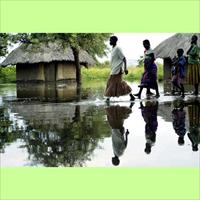BENIN: Half million potential flood victims: WHO

The World Health Organization (WHO) estimates 500,000 people are at risk of additional flooding in Benin. WHO says expected storms, the number of people living in and near recently-flooded areas, coupled with people’s unwillingness to relocate could convulse the country in more flood chaos if there is not a forced evacuation plan.
Representatives from WHO’s Cotonou office, Benin’s Ministry of Hygiene, Public Health and Social Affairs, and the municipality of Cotonou, Benin’s largest city, wrote after their 15 August visit to flooded areas in and around Cotonou that an evacuation and relocation plan is urgently needed because heavier storms are expected in September and October. “People should be evacuated if the water level approaches their windows,” the report warned.
Storms during the last week of July 2008 tore down mud and straw homes, polluted rivers, and washed away roads in the central Benin communities of Sagon, Tohoue, Dasso, Ouinhi and Za-Kpota.
In an estimate earlier this month, the Red Cross of Benin said flooding had affected almost 7,000 people, including displacing 1,560 children. Disaster workers say almost all of the displaced are taking shelter with family and friends, making it hard to know exactly how many have been forced out of their own homes.
Most of Cotonou, Benin’s economic hub, has been hit with nine out of 13 districts suffering heavy water damage and entire neighbourhoods still under water. About 10 percent of Benin’s population lives in the capital.
Heightened health worries
WHO programme officer Telesphore Houansou told IRIN every year the rains bring more water-related infectious diseases.
Since 30 July of this year, WHO has reported 192 cases of cholera in the Enagnon, Kpakpakame and Avotrou districts of Cotonou.
Ahouansou said WHO is supporting the government’s cholera treatment efforts with US$20,000, and will soon make available cholera treatment kits in Cotonou.
Warnings go unheeded
Houansou said few flood victims have been willing to leave their communities, no matter the damage. “The victims told us [WHO and government evaluators on a 15 August visit] they were attached to their homes and would not move unless there was an absolute disaster.”
The mayor’s office has said that while flooding damaged homes and roads in Cotonou, cutting off access to some areas, it had not affected telecommunications or hospital equipment.
UN agencies are working with the mayor’s office to pump out water and clear roads in the capital. WHO medical advisor Edouard Comlanvi told IRIN some northern sections of Cotonou are still under water. “The district of Vossa is completely under water. This problem of flooding is far from being resolved.”
In Micheline Akpaka’s home in the still-submerged neighbourhood Agla, she and her children continue sleeping on a table. The family must wade through more than one metre of water to reach their new makeshift bed.
In the nearby district Ayelawadje, where disaster relief staff from WHO and the government estimate flooding disrupted the lives of more than 10,000 people, Alain Mahoussi told IRIN water carried away his small mechanics shop.
Cotonou municipality’s director of technical services, Basile Gbaguidi, said flood damage is inevitable as long as people disregard warnings.
“If people continue moving into these high-risk areas, despite what we say, flooding will continue. If there is more water than what the riverbed can absorb, it will spill over and flood wherever it can.”
Benin’s Mono river typically floods into central Benin during rainy season.
In addition, Benin’s 125-kilometre coastline has hard-to-access sandbanks with no natural harbours.
The UK-based non profit International Institute for Environment and Economic Development has said a slowly rising sea level can trigger flooding , particularly in eastern Cotonou.
 Back and Next - Back and Next
Back and Next - Back and Next See Also - See Also
See Also - See Also